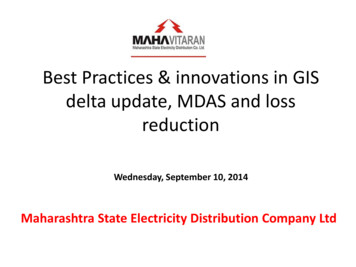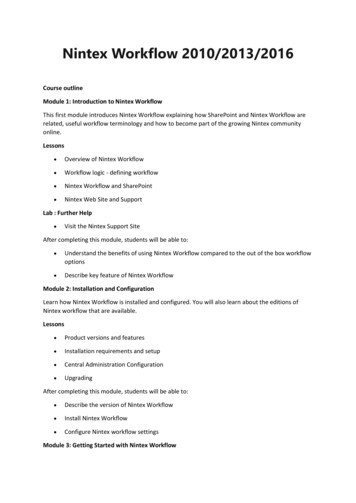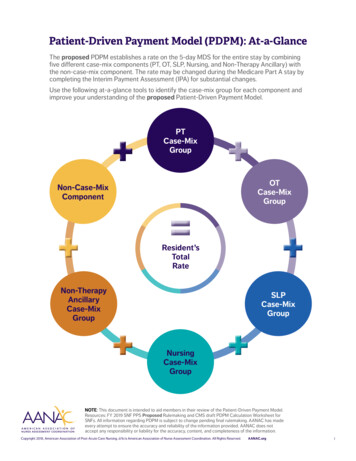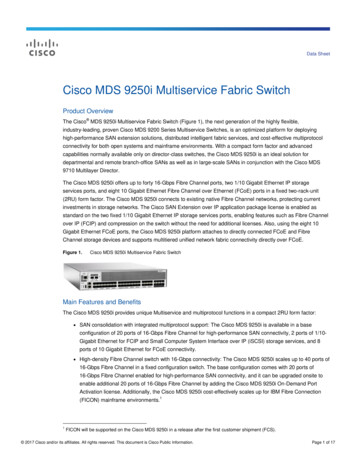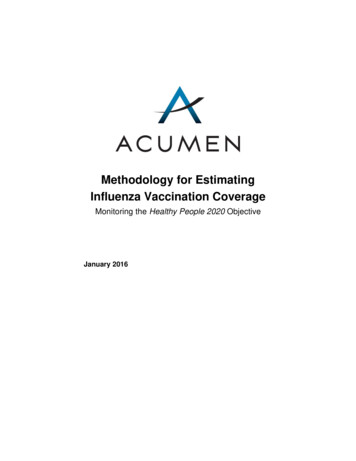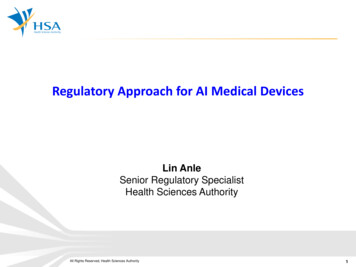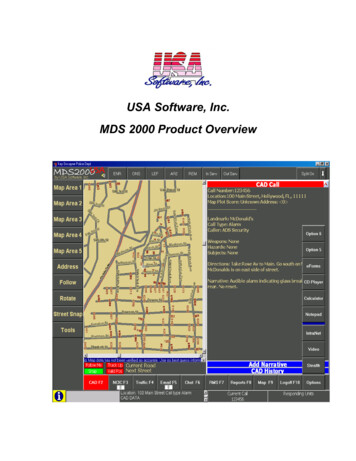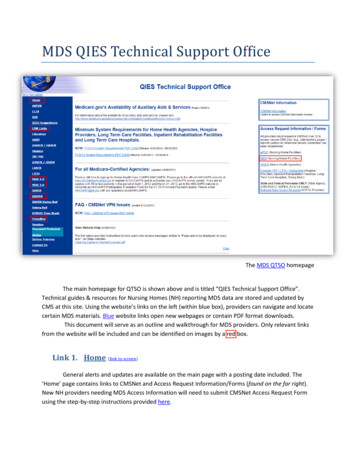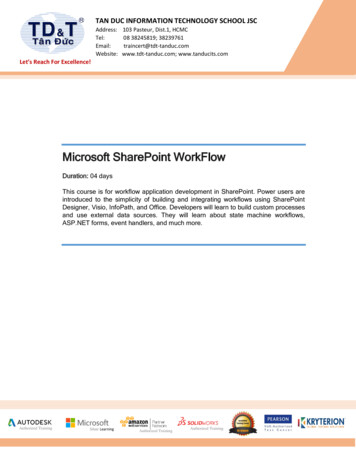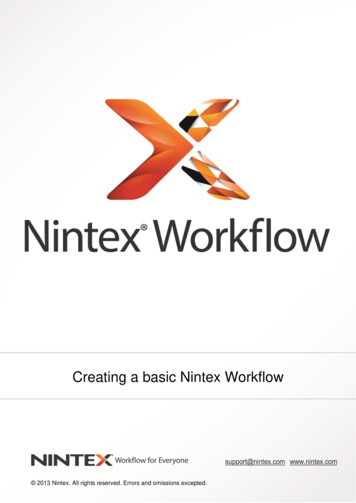
Transcription
3waysYour MDS Transmission Workflow IsHurting Reimbursement
IntroductionIs your MDS transmissionworkflow working againstyour reimbursementstrategy?You’ve done the hard work — residentinterviews, ADL flow sheets, EHR records,therapy notes the list goes on. Now all you3 Ways Your MDSTransmission Workflow IsHurting Reimbursement— especially one that includes more than16,000 long-term care facilities and 1.5 millionresidents.The good news is that the rules and regulationsThe flow of MDS data withinapply uniformly to all players. The bad news isthe facility is critical to successthat the system’s complexity makes compliancein managing reimbursement.a difficult task.have to do is transmit your MDS assessmentAnd to make matters worse, in order to bebatches to CMS.successful, skilled nursing facilities mustSimple, right? Not so fast.carefully manage their MDS workflow andtransmission in order to achieve optimalreimbursement levels.Many long-term care organizations don’t realizethat the flow of MDS data within the facility iscritical to success in managing reimbursement.Under the single umbrella known as MDS 3.0,CMS has created a complex system that aims tocover the full breadth of resident care, qualityHave you fully evaluated your MDS informationand transmission process and its impact onyour organization?measures and facility reimbursement acrossThis eBook lays out three key areas related tothe country. That’s a tall order for any systemMDS workflow and transmission that might behurting your reimbursement strategies.1
#1Manual MDS transmission slowsworkflow and compounds errorsAutomating data makessenseAn inefficient process fortransmissionA key area where a long-term care facility’sreimbursement may be affected by a manualprocess is in the transmission of MDS batchesInserting a manual transmissioninto the MDS workflowto CMS. In this scenario, the work relateddiminishes the value of bothIn a world where data is constantly flowing,to creating the MDS assessment has beenchanging and increasing in volume, it simplyhuman capital and IT systems.completed and only transmission remains.makes sense to automate. In fact, dataautomation has become such an integral part ofour lives that we’ve almost stopped noticing it.For example, email is an important part of yourprofessional life. But what if you had to stopwhat you were doing and manually sync yourcomputer to check for new messages? Whatif you were expecting an important text butWhat happens now? Automation stops andcouldn’t receive it until you manually instructedthe MDS staff has to physically manipulateyour phone to connect to your service provider?data files (which include protected healthThese scenarios seem ridiculous in today’sworld. Unfortunately, many data processes inlong-term care are still performed manually.And this can add up to a significant cost overtime.information), connect to the remote CMSservers via VPN, and manually transferassessment batches. Then there is usually aseparate but similar process to retrieve CASPERreports from CMS.2
#1 Manual MDS transmission slows workflow and compounds errorsThis is where the productivity of MDS staff andIncreased likelihood of errors. When staffthe usefulness of automated clinical systemstime is taken up by a cumbersome manualfalter. Inserting a manual process like this intoprocess, it becomes more likely that MDS errorsthe MDS workflow diminishes the value of bothand rejects will be overlooked. This becomeshuman capital and IT systems.magnified when there is frequent employeeturnover or limited staff training.How is reimbursementaffected?Magnification of inefficiencies. A manualprocess creates inefficiencies that can addup over time. As with any manual process,Reducing manual processeseliminates errors and allowsinformation to flow in a morecontrolled and measurable way.small errors become compounded, especiallyas workloads and regulatory requirementsincrease.A manual MDS transmission process canBenefits of automationnegatively affect reimbursement because itA manual data process is like walking onleads to:Less focus on areas of strategic value. Theinclusion of this manual process into the MDSworkflow leaves less time for staff to focuson MDS accuracy and efficiency. Their focus isdevoted to a time-consuming process ratherthan being directed to areas of strategic valuea treadmill. While you’re doing it, you’reaccomplishing something but can’t focus onother tasks. When you automate the process,you step off the treadmill and let it run byitself while you turn your attention to moreimportant areas — including those that directlyaffect the bottom line.to the facility.3
#1 Manual MDS transmission slows workflow and compounds errorsIn addition, all your CMS data — FinalValidations, CASPER reports and QI/QMdata — are retrieved automatically as part ofthe same process and displayed in a simpledashboard view, allowing MDS staff to easilytrack warnings, and correct issues and resubmitrejects in minutes.Reducing manual processes not only eliminateserrors, it allows information to flow in amore controlled and measurable way. Withautomation, staff can do more work moreeasily. Workflow improves across the facility,and reimbursement and profitability naturallyincrease.The solution: Automate CMStransmissionTHE TAKEAWAYAutomating MDStransmission minimizeserrors and allows staffto focus on areas ofstrategic value.This automated workflow creates a processthat is as near to real-time as possible, andeliminates errors that a manual processinevitably brings.The alternative to the cumbersome manualMDS process is an automated MDS transmissionworkflow. This means that as soon as yourclinical system creates an MDS batch, it isautomatically detected and submitted to CMSwithout any manual intervention.4
#2Lack of visibility means missedbilling opportunitiesA limited view of dataA big reason that long-term care facilities failIt’s no secret that analyzing and understandingthat they don’t have a complete picture of theirdata has become fundamental to success in anyMDS transmission workflow.to achieve optimal reimbursement, however, isindustry. In order to stay ahead of competitionWithout a complete picture ofMDS transmission workflow,and changing regulations, businesses must notonly have access to all their data, but be ableLTC facilities fail to achieveto view it in an understandable and actionableoptimal reimbursement.way.The key words here are understandableand actionable.Rather than seeing a top-level view of all MDStransmission activity, which ideally includes anend-to-end picture of the workflow down to theindividual MDS assessment and resident, MDSThis is one reason we hear so much aboutstaff are often limited to manually searching ondashboards these days. A dashboard providesa granular basis for MDS rejects and exceptions.a simple view of data and key performanceBecause they don’t have the power to see theindicators (KPIs) that relate to a particularbig picture, it’s easy to overlook errors and missbusiness objective or process. The goal is tobilling opportunities.highlight key information about the business sothat managers know where changes need to bemade.In addition, the limitations of accessingreports and data directly from CMS lead toeasily missing key indicators. The data may beavailable from CMS, but is often overlookedbecause of the difficulty in accessing it.5
#2 Lack of visibility means missed billing opportunitiesWhat about multiplefacilities?With a clear view of the data, regional andcorporate staff can easily analyze qualitymeasures across multiple facilities. Activitycan be viewed by batch or assessment and theresults filtered by facility or status, allowingquick diagnose and resolution of problems.Unfortunately, in regard to the traditional MDSworkflow, the manual process for managingMDS transmission means that organizationswith multiple facilities have a severelyrestricted view of their data. Limited to amanual process, business office managers andreimbursement specialists can’t see the bigpicture of their MDS workflow – which directlyThe ability to see data across the enterprisethat is both understandable and actionablemeans that MDS reimbursement can beaddressed as a targeted business strategy, notA clear view of MDS dataallows reimbursement tobe addressed as a targetedbusiness strategy, not just ashot in the dark.just a shot in the dark.How is reimbursementaffected?impacts facility reimbursement – much lesssee what that picture looks like across multiplefacilities in an organization.For long-term care organizations with multiplefacilities, the need for a management-level,actionable view of MDS transmission dataA limited view of MDS transmission workflowis clear. This is where the true power of ancan negatively affect reimbursement because itautomated MDS transmission managementleads to:dashboard comes into play. The dashboardview allows managers to see a clear pictureof reimbursement outcomes across the entireenterprise and shows them where action isrequired.Missed billing opportunities. A limited viewof data means that key indicators and billingopportunities are easily overlooked. Overtime, this can add up to a big impact on anorganization’s overall reimbursement.6
#2 Lack of visibility means missed billing opportunitiesCompounding of errors over time. The manualassessments were accepted, accepted withprocess of MDS transmission, coupled with awarnings or rejected. Staff can then instantlylack of insight into the data, means that errorsanalyze problem areas and correct errors withinin transmission and data analysis more easilyminutes.occur. This scenario only gets worse as theTHE TAKEAWAYvolume of data grows.Under-performing facilities. Without a toplevel view of the MDS transmission workflowCASPERacross multiple facilities, it’s impossible tocompare performance of individual facilitiesand staff members. Both accountability andreimbursement can suffer.The solution: Acomprehensive MDSdashboard viewTrying to understand MDS workflow via a singleTo quickly research rejected assessments,simply filter the assessment view to see onlyrejects. Your most recent assessment appearsTo truly optimizereimbursement andminimize MDS errors,facilities need a full360-degree view oftheir MDS processes.first and one click opens the Final Validationreport to the error message. Another click andyou can view the MDS as a PDF or in its nativeXML format and quickly assess the issue.manual transmission episode is like lookingIn addition, all your CMS and CASPERthrough a keyhole. A few things are visiblereports are accessible in one place. You canbut it’s far from a complete picture. To trulyview and print Initial Feedback and Finaloptimize reimbursement and minimize MDSValidation reports, as well as two years oferrors, facilities need a full 360-degree view ofMDS assessments, Initial Feedback and Finaltheir entire MDS process. What would this kindValidation reports. Items over two years old areof view look like?automatically archived for retrieval at any time.A 360-degree view of the MDS process includesan intuitive dashboard view of all your MDSactivity, allowing you instantly to see whether7
#3CMSNet VPN slows workflowand can lead to PHI security gapsA cumbersome VPN processtransmit MDS assessments or retrieve CASPERA common complaint from both skilled nursingusers cannot access any network resourcesfacilities and their IT support groups is that— including printers, files, network drives, orutilizing the CMSNet VPN (Verizon VPN) tothe Internet — during the MDS transmissiontransmit MDS assessments is difficult andand reporting process, which slows downcumbersome. Managed by the QIES Technicalproductivity.reports, everything else must stop. In addition,Both IT and MDS staff mustmanage a separate technicaltransmission process, whichSupport Office (QTSO), the CMSNet VPN allowscan affect both productivitynursing facilities to exchange informationand reimbursement.securely with CMS, but it comes with its own setof limitations and technical risks.IT departments dislike the CMSNet VPNbecause they have to support it. Often thiseffort involves a number of processes that areoutside their normal responsibilities, includingIn short, because both IT and MDS staff musthaving to manage special hardware andmanage a separate technical transmissionsoftware, creating workarounds for networkprocess, this opens up the possibility tolimitations the VPN imposes, and the ongoingadditional manual errors along the way.training required by MDS staff who areresponsible for transmission.The combination of those errors and a slowerworkflow mean that the MDS transmissionMDS staff complain that managing transmissionprocess is not running optimally. Andvia the CMSNet VPN is a serious interruption toultimately this can affect both productivity andtheir workflow. This is because when it’s time toreimbursement.8
#3 CMSNet VPN slows workflow and can lead to PHI security gapsIs PHI at risk?transmission, creating a new copy of the files.The CMSNet VPN is designed to create a greattransmission machine may not be subject todeal of security for CMS itself. But did you knowthe same level of security as the clinical system.that an unintentional consequence of the VPNWorse yet, some facilities may use flash drivesis the creation of potential security risks to PHIor other insecure methods to move files for(protected health information)?transmission.Depending on the IT protocols in place, theOften there’s little or no ongoing securityoversight when MDS files get copied orMDS transmission via theCMSNet VPN distracts stafffrom strategic functions andendangers PHI.transferred, and no guarantee they are properlysecured or deleted after manual transmissionactivities are complete.In 2013, CMS alerted all CMSNet users to a“major change” to security that affects the wayproviders manage their data and reports whileconnecting to CMS. The change improved theHow is reimbursementaffected?security of the VPN while users are connected,but as a result significantly limited the abilityof MDS staff to manage MDS files, reports andprinting tasks while connected.Unfortunately this is more than just aninconvenience. In many cases it forces facilitiesto create multiple copies of MDS files — whichinclude PHI in assessments — and store them inmultiple locations.For example, once an MDS batch is created, theMDS nurse might then move the batch fromthe clinical system to a separate computer forManual MDS transmission via the CMSNetVPN can negatively affect reimbursement andprofitability because it:Distracts staff from strategic functions.Instead of focusing on key strategic processes,clinical and IT staff must perform and supporta cumbersome manual process. This invites9
#3 CMSNet VPN slows workflow and can lead to PHI security gapsmanual errors and slows workflow, whichThey say things like:ultimately affects both productivity andreimbursement.“I can’t begin to tell you whatEndangers PHI and risks OIG penalties. In aa pain it was to go through therecent high-profile case, a dermatology firmVPN just to upload MDS’s andwas fined 150,000 by HHS for losing a thumbthen again to get validationdrive containing patient information. This isexactly the type of security risk that occur whenmanaging multiple copies of MDS data files.The alternative: Avoid theVPNreports. With your site it’s aseasy as pie. Thank you!!”“Makes my job less stressful.Thanks for giving me ’no-worry’THE TAKEAWAYAutomating MDStransmission workflowprotects PHI and createsa more logical workflowthat leads to moreoptimal reimbursement.transmissions!”We’ve heard time and time again from facilitiesBut an automated MDS transmission workflowthat one of their biggest headaches is theis about more than added convenience. It’sCMSNet VPN. Taking the VPN out of the middleabout creating a smoother, more logicalof the workflow for facilities frequently resultsworkflow that fits staff needs and createsin audible sighs of relief from both MDS and ITan environment where fewer errors andstaff.interruptions can lead to more optimalreimbursement.10
What is SimpleMDS ?Best practice for MDSworkflow automationSimpleMDS is the proven, best-practiceMDS transmission workflow automationsolution for long-term care.Why is SimpleMDS the most popular softwaresolution for MDS workflow management?Because it automates transmissionworkflow, eliminates delays and optimizesreimbursement, even across multiple facilities.With SimpleMDS, you can achieve a 360-degreeview of your MDS transmission workflow. MDSassessments are automatically transmitted toCMS upon completion.No cumbersome VPN (CMSnet Verizon VPN)is required. Your CMS/CASPER reports areretrieved automatically in a simple dashboardview. You can easily track warnings, and correctand resubmit rejects in minutes.Key benefits360-degree view of your MDS transmissionCorrect and resubmit rejects in minutesworkflow, even across multiple facilitiesAutomatically retrieve reports: MDS,Optimize reimbursement and eliminateCASPER and QI/QM reportsmanual errorsSimple dashboard view of all your dataAutomatically transmit MDS assessments toNo VPN requiredCMS11
What is SimpleMDS ?Customers are saying.Super simple and easyto use, a real time saver,which is paramountin the long term careindustry’s workloadinvolving the residentassessment, billingand reimbursementprocesses.— RN/MDS CoordinatorI’m 100% satisfied with the program andcouldn’t be more happy! I love the factthat I can access our reports and do all ofmy transmitting work at the same site.— MDS CoordinatorSimpleLTC makesmy life so mucheasier.LOVE IT!— Regional ReimbursementConsultantI wish I hadthis yearsago!— MDS Case ManagerI can gather information on residentsquickly and efficiently. Saves a lot of timeand helps me see billable people that arenot normally detectable.— Billing CoordinatorSimpleMDS by the numbers12
Long-term care software people love to useSimpleMDS Best practice for MDS workflow automation,quality measurement and CMS report accessStart your FREE 30-day trial!Share this eBook with your friends!simpleltc.com13
utilizing the CMSNet VPN (Verizon VPN) to transmit MDS assessments is difficult and cumbersome. Managed by the QIES Technical Support Office (QTSO), the CMSNet VPN allows nursing facilities to exchange information securely with CMS, but it comes with its own set of limitations and technical risks. IT departments dislike the CMSNet VPN
